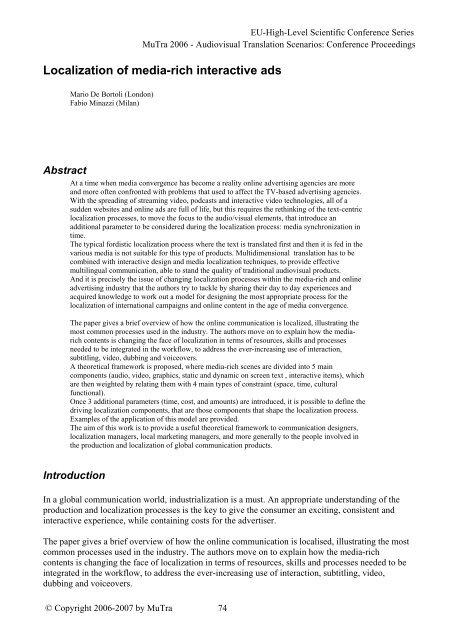Proceedings - Translation Concepts
Proceedings - Translation Concepts
Proceedings - Translation Concepts
Create successful ePaper yourself
Turn your PDF publications into a flip-book with our unique Google optimized e-Paper software.
EU-High-Level Scientific Conference Series<br />
MuTra 2006 - Audiovisual <strong>Translation</strong> Scenarios: Conference <strong>Proceedings</strong><br />
Localization of media-rich interactive ads<br />
Mario De Bortoli (London)<br />
Fabio Minazzi (Milan)<br />
Abstract<br />
At a time when media convergence has become a reality online advertising agencies are more<br />
and more often confronted with problems that used to affect the TV-based advertising agencies.<br />
With the spreading of streaming video, podcasts and interactive video technologies, all of a<br />
sudden websites and online ads are full of life, but this requires the rethinking of the text-centric<br />
localization processes, to move the focus to the audio/visual elements, that introduce an<br />
additional parameter to be considered during the localization process: media synchronization in<br />
time.<br />
The typical fordistic localization process where the text is translated first and then it is fed in the<br />
various media is not suitable for this type of products. Multidimensional translation has to be<br />
combined with interactive design and media localization techniques, to provide effective<br />
multilingual communication, able to stand the quality of traditional audiovisual products.<br />
And it is precisely the issue of changing localization processes within the media-rich and online<br />
advertising industry that the authors try to tackle by sharing their day to day experiences and<br />
acquired knowledge to work out a model for designing the most appropriate process for the<br />
localization of international campaigns and online content in the age of media convergence.<br />
The paper gives a brief overview of how the online communication is localized, illustrating the<br />
most common processes used in the industry. The authors move on to explain how the mediarich<br />
contents is changing the face of localization in terms of resources, skills and processes<br />
needed to be integrated in the workflow, to address the ever-increasing use of interaction,<br />
subtitling, video, dubbing and voiceovers.<br />
A theoretical framework is proposed, where media-rich scenes are divided into 5 main<br />
components (audio, video, graphics, static and dynamic on screen text , interactive items), which<br />
are then weighted by relating them with 4 main types of constraint (space, time, cultural<br />
functional).<br />
Once 3 additional parameters (time, cost, and amounts) are introduced, it is possible to define the<br />
driving localization components, that are those components that shape the localization process.<br />
Examples of the application of this model are provided.<br />
The aim of this work is to provide a useful theoretical framework to communication designers,<br />
localization managers, local marketing managers, and more generally to the people involved in<br />
the production and localization of global communication products.<br />
Introduction<br />
In a global communication world, industrialization is a must. An appropriate understanding of the<br />
production and localization processes is the key to give the consumer an exciting, consistent and<br />
interactive experience, while containing costs for the advertiser.<br />
The paper gives a brief overview of how the online communication is localised, illustrating the most<br />
common processes used in the industry. The authors move on to explain how the media-rich<br />
contents is changing the face of localization in terms of resources, skills and processes needed to be<br />
integrated in the workflow, to address the ever-increasing use of interaction, subtitling, video,<br />
dubbing and voiceovers.<br />
© Copyright 2006-2007 by MuTra 74
















